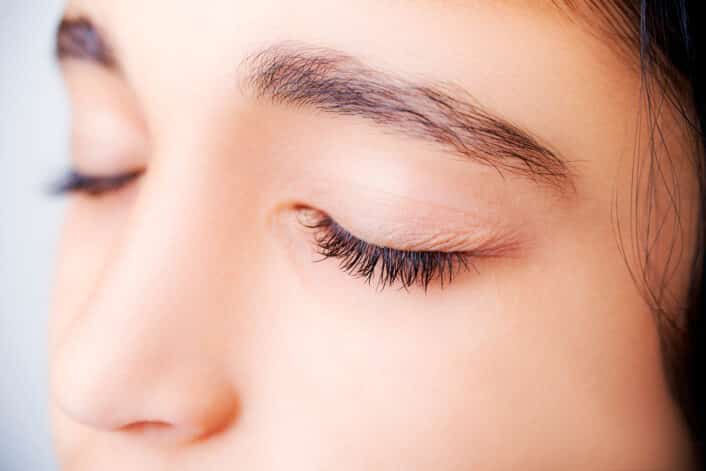

Disclaimer: This article is for informational purposes only and is not intended to diagnose any conditions. LifeDNA does not provide diagnostic services for any conditions mentioned in this or any other article.
Distichiasis, or double eyelashes, is a rare condition where an individual has an extra row of eyelashes. This second row can range from a single additional lash to a complete set. The extra eyelashes are typically thinner, shorter, and lighter than normal ones. While distichiasis usually affects all four eyelids, it can sometimes appear on just one eyelid or the lower lids. The extra lashes emerge from the meibomian glands, which normally produce an oil that prevents tears from evaporating too quickly.
Many people with double eyelashes have no symptoms. However, when symptoms do appear, they can include:
Visible Extra Eyelashes: The most noticeable sign is the presence of an extra row of eyelashes behind the natural lashes.
Eye Irritation and Discomfort: The extra lashes may rub against the surface of the eye, leading to:
Recurrent Eye Infections: Individuals with double eyelashes may experience frequent styes or painful bumps on the eyelids caused by clogged oil glands. Other infections such as conjunctivitis (pink eye); nflammation or infection of the transparent membrane covering the eye.
Corneal Issues: Scratches or scarring on the cornea may occur due to friction from the extra lashes, potentially leading to vision problems.
Double eyelashes can be present at birth (congenital) or develop later in life (acquired).
Congenital double eyelashes are typically caused by a genetic mutation affecting eyelid development. The most well-known genetic cause is a mutation in the FOXC2 gene, located on chromosome 16. This gene plays a crucial role in the development of the lymphatic and vascular systems, and when altered, it can result in an extra row of eyelashes.
In many cases, congenital double eyelashes are associated with Lymphedema-Distichiasis Syndrome (LDS), a rare disorder that combines double eyelashes with lymphedema, a condition in which excess fluid builds up in body tissues. People with LDS may also experience:
While congenital double eyelashes may exist on their own, they are often linked to these broader genetic concerns, making regular medical check-ups essential.
Acquired double eyelashes develop later in life due to inflammation or injury to the eyelids. Common causes include:
Eyelid Inflammation
Long-term inflammation of the eyelids can lead to the development of double eyelashes. Chronic inflammation of the eyelids (blepharitis) is a common cause, resulting from bacterial infections or skin conditions that cause irritation, dryness, and crusting around the eyelids. Another condition, Meibomian gland dysfunction (MGD), occurs when the glands responsible for producing the eye’s protective oil layer become blocked or inflamed, disrupting normal eye lubrication. Ocular rosacea, a skin disorder that affects the eyes as well, can also contribute to double eyelashes by causing persistent redness, dryness, and irritation.
Autoimmune and Allergic Disorders
Certain autoimmune and allergic disorders may cause acquired double eyelashes. Ocular cicatricial pemphigoid (OCP) is a rare autoimmune disorder that may lead to chronic conjunctivitis and scarring, which can result in abnormal lash growth. Stevens-Johnson syndrome is another serious condition, often triggered by an allergic reaction to medications or infections. This syndrome causes widespread inflammation of the skin and mucous membranes, including the eyelids, which may contribute to double eyelashes.
Injury and Chemical Exposure
Physical trauma or chemical exposure can also lead to double eyelashes. Chemical burns from strong substances can damage the eyelids and disrupt normal hair follicle development, leading to abnormal lash growth. Similarly, direct physical injury to the eyelids can alter the natural growth pattern of eyelashes, sometimes resulting in the emergence of extra lashes.
A healthcare provider can diagnose double eyelashes through an eye exam, often using a slit-lamp test. This specialized microscope provides a magnified view of the eye, helping detect extra lashes and associated issues like corneal irritation or scarring.
If double eyelashes do not cause discomfort, treatment may not be necessary. However, for individuals experiencing irritation or complications, there are several treatment options available.
Congenital double eyelashes cannot be prevented. However, individuals with LDS may benefit from genetic counseling to understand their risks and options.
To reduce the risk of acquired double eyelashes, you can:
The prognosis for double eyelashes is generally good. Many people experience no symptoms, while others find relief with lubricating eye drops or contact lenses. If lash removal is needed, multiple treatment sessions may be required to prevent regrowth.
If you have persistent eye irritation, redness, or discomfort, you should see an eye doctor. If you have been diagnosed with double eyelashes, consult your doctor about treatment options, especially if you experience frequent infections or vision problems. Genetic counseling may also be beneficial for individuals with LDS.


